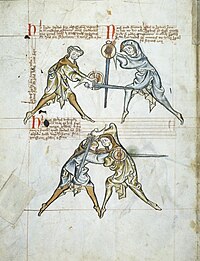Royal Armouries Ms. I.33


Royal Armouries Ms. I.33is the earliest known surviving Europeanfechtbuch(combat manual), and one of the oldest surviving martial arts manuals dealing with armed combat worldwide. I.33 is also known as the Walpurgis manuscript, after a figure named Walpurgis shown in the last sequence of the manuscript,[1]and "the Tower manuscript" because it was kept in theTower of Londonduring 1950-1996; also referred to asBritish MuseumNo. 14 E iii, No. 20, D. vi.
It was created around 1300 inFranconiaand is first mentioned byHenricus a Gunterrodtin hisDe veriis principiis artis dimicatoriaeof 1579.
The manuscript is anonymous[2]and is so titled through an association with theRoyal Armouries Museum.[1]
The manuscript
[edit]The manuscript including the text date to about 1270-1320 AD[3][4][5][6]It is first mentioned byHenricus a Gunterrodtin hisDe veriis principiis artis dimicatoriaeof 1579, where he reports it to have been acquired (looted) by a friend of his, one Johannes Herbart ofWürzburgwhen serving in the force ofAlbert Alcibiades, Margrave of Brandenburg-Kulmbachin the campaigns of 1552/3. It remained in a Franconian monastery (presumably inUpper Franconia) until the mid-16th century. From the 17th century, the manuscript was part of the ducal library ofGotha(signatureCod. Membr. I. no. 115) until it disappeared inWorld War IIand resurfaced at aSotheby'sauction in 1950, where it was purchased by theRoyal Armouries.The author of the treatise may be a cleric calledLutegerus(viz. a Latinised form of the German proper nameLiutger).
The treatise expounds a martial system of defensive and offensive techniques between a master and a pupil, referred to assacerdos(priest) andscolaris(student), each armed with a sword and a buckler, drawn in ink and watercolour and accompanied with Latin text, interspersed with German fencing terms. On the last two pages, the pupil is replaced by a woman called Walpurgis.
The pages of the manuscript arevellum,[7]the 32 parchment folia (64 pages) of the manuscript show Latin text written in a clerical hand, using the varioussiglawhich were standard at the time (but which fell out of use at the end of the medieval period; an image from the manuscript (the second image on fol 26r) was copied intoCodex Guelf 125.16.Extrav.in the 1600s by a draughtsman who under his drawing stated that he could not decipher the Latin text).
Contents
[edit]The pages are thought possibly or very likely from an earlier larger work, which have later been subsequently bound together separated from the other pages.[6][7]The text provides guidance on the use of asingle-handed sword.[8]The fencing system is based on a number ofwards(custodie) which are answered by defensive postures (obsessiones). The wards are numbered 1 to 7 on the first two pages and supplemented by various 'special' wards later in the text. The seven basic wards are:
- under the arm (sub brach)
- right shoulder (humero dextrali)
- left shoulder (humero sinistro)
- head (capiti)
- right side (latere dextro)
- breast (pectori)
- 'long-point' (langort)
The German terms appearing in the Latin text are the following:
- albersleiben(possibly thefool's guardposition)
- durchtreten,durchtritt('stepping through')
- halpschilt('half shield', one of theobsessiones)
- krucke('crutch', a defensive position)
- langort('long-point', may be either acustodiaor anobsessio)
- nucken('nudge', a specific attack)
- schiltslac('shield-blow')
- schutzen('protect')
- stich('stab')
- stichschlac('stab-blow')
- vidilpoge('fiddle-bow', a specificcustodia)
Sporadic dialectal elements in these terms (notablynuckenandhalpschilt) suggest a location of composition consistent with the reported discovery in aFranconianmonastery in the wider area ofWürzburg.
References
[edit]- ^abKenner, Andrew (2014).I33: Fencing in the Style of the Walpurgis Manuscript.Lulu Enterprises Incorporated. p. 11.ISBN9781291649475.
- ^Green, Thomas A; Svinth, Joseph R (2010).Martial Arts of the World: An Encyclopedia of History and Innovation.Vol. 2. ABC-CLIO 2010. p. 244.ISBN978-1598842432.
- ^Kellett, Rachel E (2012). "Royal Armouries MS I.33: The Judicial Combat And The Art Of Fencing In Thirteenth- And Fourteenth-Century German Literature".Oxford German Studies.41(1): 32–56.doi:10.1179/0078719112Z.0000000003.S2CID161823139.
- ^Wadge, Richard (2015).Verneuil 1424: The Second Agincourt: The Battle of Three Kingdoms.History Press.ISBN978-0750963350.
- ^The manuscript is dated to the "late 13th century" in the description by Royal Armouries.Alphonse Lhotskyin a handwritten note suggested the late 13th century and identified the scribe as a secretary to the bishop ofWürzburg.
- ^abHester, James (2012). "A Few Leaves Short of a Quire: Is the 'Tower Fechtbuch' Incomplete?".Arms & Armour.9(1): 20–24.doi:10.1179/1741612411Z.0000000003.S2CID161975656.
- ^abMorgan, Martin (Spring 2014). "Publishing Royal Armouries 1.33 - The Illuminated Fightbook".Arms & Armour.11(1): 68–70.doi:10.1179/1741612414Z.00000000033.S2CID161204950.
- ^Windsor, Guy (2013).The Swordsman's Companion: A Modern Training Manual for Medieval Longsword.Guy Windsor.ISBN978-9526793429.
- Jeffrey L. Singman (now Forgeng), "The medieval swordsman: a 13th century German fencing manuscript", inRoyal Armouries Yearbook 2,pp. 129–136, 1997.
- Jeffrey L. Forgeng,The Medieval Art of Swordsmanship, A Facsimile & Translation of the World's Oldest Personal Combat Treatise,published jointly with the Royal Armouries at Leeds,The Chivalry Bookshelf,2003;ISBN1-891448-38-2
- Paul Wagner & Stephen Hand,Medieval Sword And Shield: The Combat System of Royal Armouries MS I.33,The Chivalry Bookshelf, 2003;ISBN1-891448-43-9
- Stephen Hand, "Re-Interpreting Aspects of the Sword & Buckler System in Royal Armouries MS I.33", inSpada 2: Anthology of Swordsmanship,pp. 91–109, The Chivalry Bookshelf, 2005;ISBN1-891448-35-8
- Franck Cinato & André Surprenant,Le livre de l’art du combat. Liber de arte dimicatoria. Édition critique du Royal Armouries MS. I.33, collection Sources d'Histoire Médiévale n°39,CNRS Editions, Paris, 2009.ISBN978-2-271-06757-9
External links
[edit]- Official Royal Armouries collection catalogue record of manuscript I.33,(collections.royalarmouries.org)
- The Illuminated Fight Book,facsimile project
- Walpurgis Fechtbuch (MS I.33)(wiktenauer )
- Full text of I.33 and translation (schwertfechten.ch)
- David Rawlings,Obsesseo: The Art of Sword and Bucklertraining DVD (London Longsword Academy/Boar's Tooth)
- A Partial, Possible Interpretation of the I.33 Manuscriptby John Jordan
- Demonstration of basic attacksincludes slow-motion video clips (Higgins Armory Sword Guild)
- Anonymous Fechtbuch: Manuscript I.33(TheAssociation for Renaissance Martial Arts)
- The Guards of I.33 and Their Footwork and Cutsby Randall Pleasant (The Association for Renaissance Martial Arts)
- Fall Under the Sword and Shield: An Examination of the First Play of MS I.33by Randall Pleasant (The Association for Renaissance Martial Arts)
- A comparative pictorial study of the Wards and techniques of the I.33 or Tower Fechtbuchby Brian Hunt (The Association for Renaissance Martial Arts)
